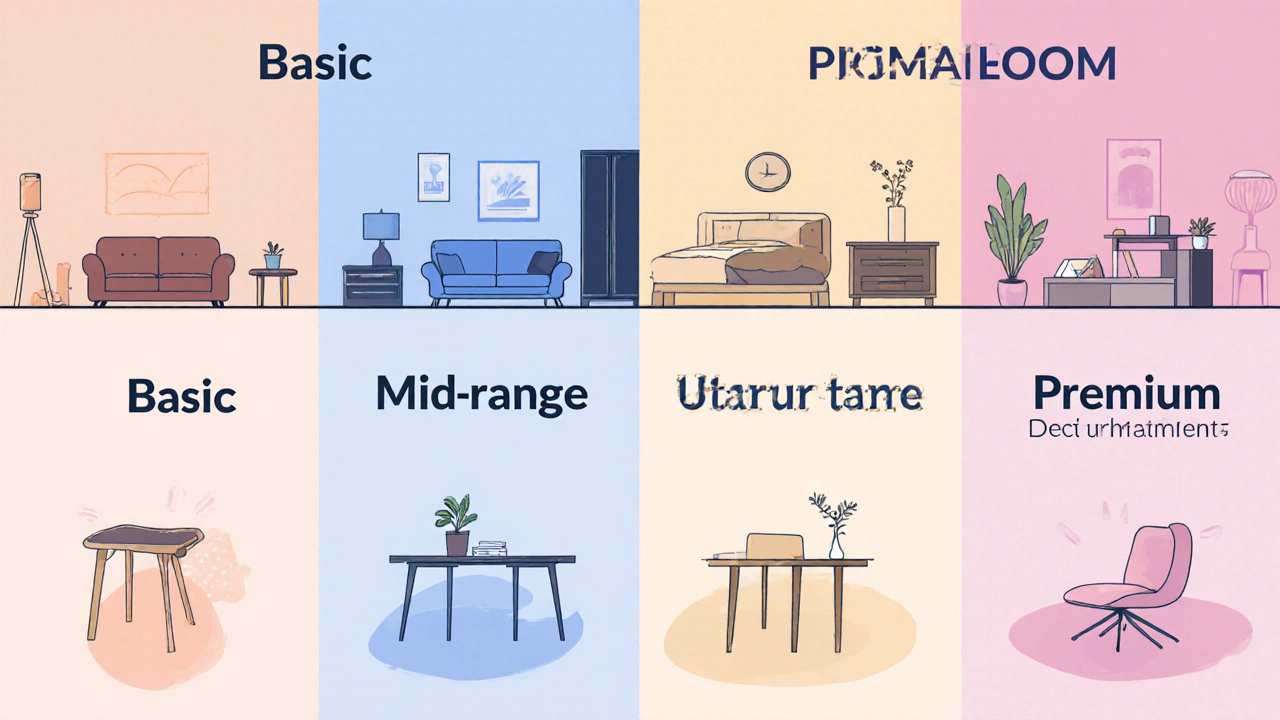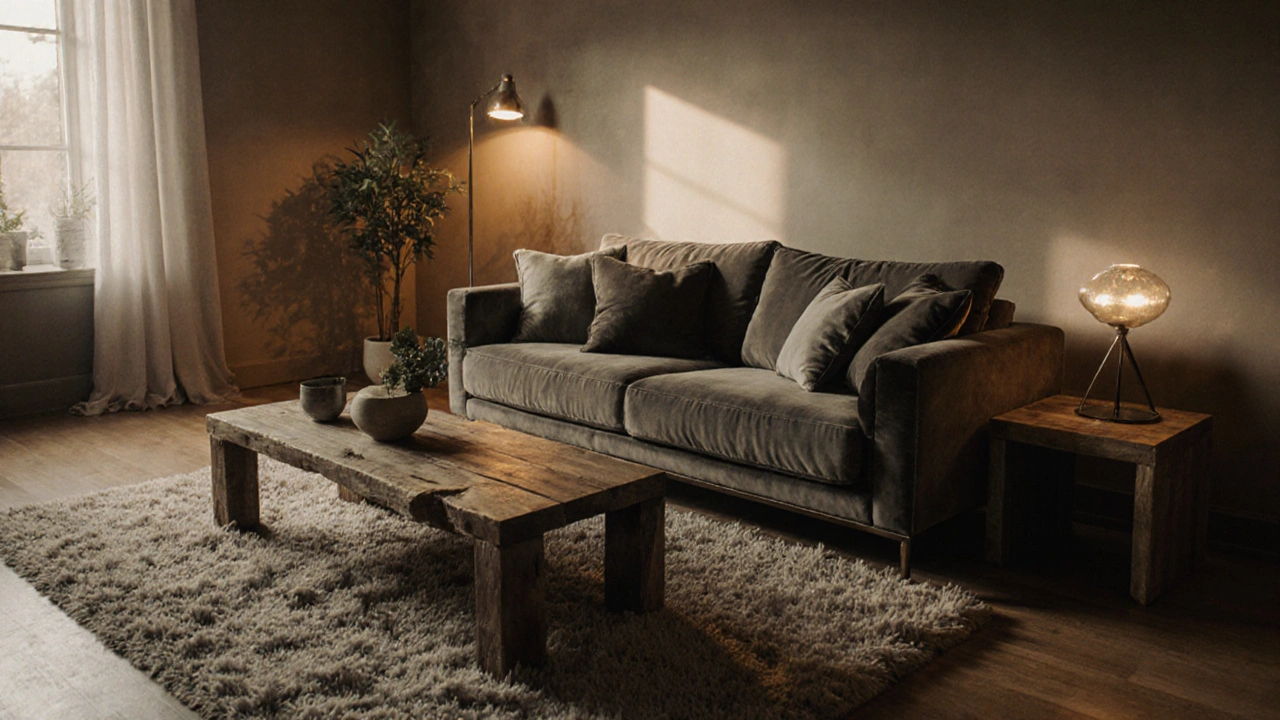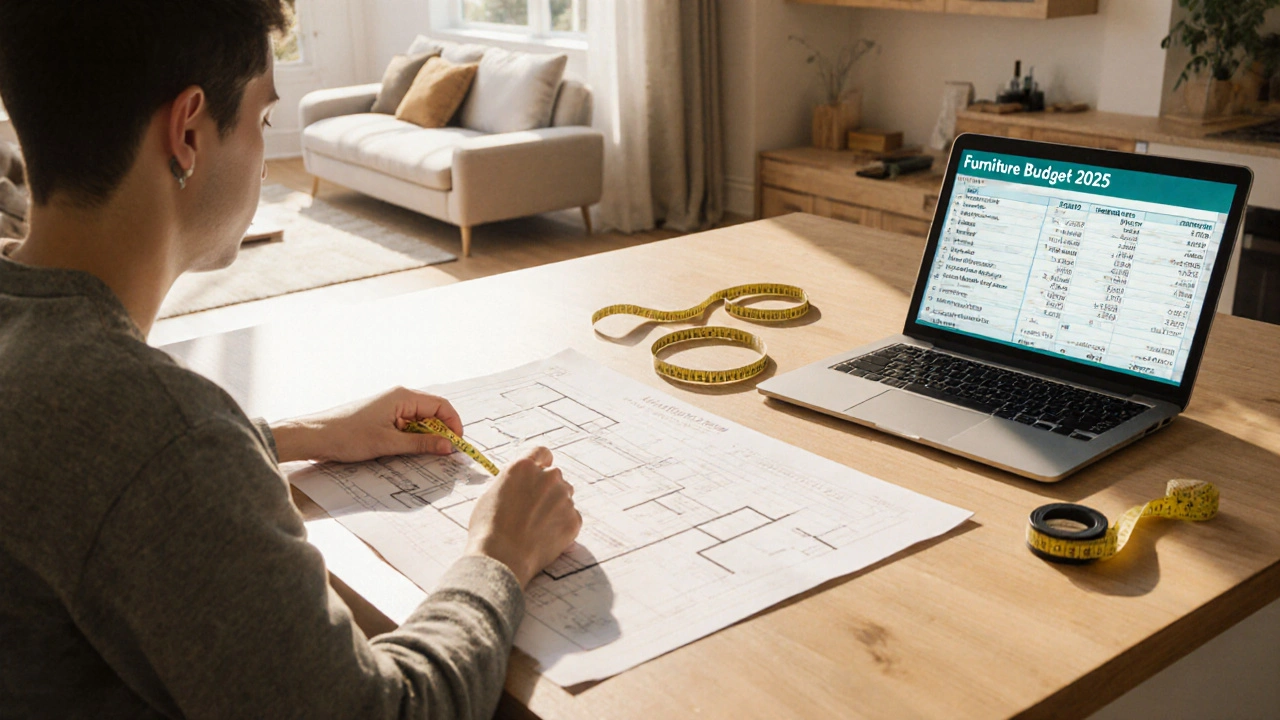Furniture Budget Calculator
Room Selection
Select which rooms you need to furnish
Budget Level
Select your preferred furniture budget level for each room
Additional Costs
Include hidden fees in your budget
Inflation Buffer
Add a buffer for inflation and unexpected costs
Your Total Budget
Breakdown:
When you start thinking about filling a new place or refreshing an old one, the biggest question that pops up is furniture budget. How much money should you actually set aside so you don’t end up scrambling for cash or, worse, buying cheap pieces you’ll regret?
Furniture budget is a financial plan that outlines how much you’ll spend on home furniture over a given period. It takes into account room priorities, style choices, delivery fees, and even inflation. Getting this plan right can save you months of stress and keep your living space looking polished.
Why a Dedicated Furniture Budget Matters
- Prevents overspending: Knowing your limit means you won’t fall for impulse deals.
- Ensures balance: You can allocate money fairly across living room, bedroom, dining, and home office.
- Helps with financing: If you need a payment plan, a clear budget makes negotiations smoother.
Most people underestimate hidden costs-delivery, assembly, warranty extensions, and even the price of protective floor pads. A well‑crafted budget captures those extras before they surprise you.
Step‑by‑Step Blueprint to Calculate Your Furniture Budget
- Assess Your Space: Measure each room’s square footage. Knowing the size helps you estimate how many pieces you really need.
- Set Priorities: Decide which rooms are mission‑critical (e.g., bedroom for sleep, living room for family time) and which can wait.
- Research Average Costs: Use the table below as a starting point. Adjust for style, brand, and regional price differences.
- Add Hidden Fees: Include delivery (usually 5‑10 % of item price), assembly (average $50‑$150 per item), and warranty (around 10 % of product cost for 3‑year coverage).
- Apply a Buffer: Inflation and unexpected price hikes are real. Add a 5‑7 % buffer to your total.
- Finalize the Number: Sum everything, round up to the nearest $100, and that’s the amount you should set aside.
Average Furniture Costs by Room (2025)
| Room | Basic (budget) | Mid‑range | Premium |
|---|---|---|---|
| Living room | $1,200 - $2,000 | $2,500 - $4,500 | $5,000 - $10,000+ |
| Bedroom | $800 - $1,500 | $2,000 - $3,500 | $4,000 - $7,500+ |
| Dining room | $600 - $1,200 | $1,800 - $3,000 | $4,000 - $8,000+ |
| Home office | $400 - $900 | $1,200 - $2,200 | $3,000 - $5,500+ |
These figures include a standard sofa or sectional for the living room, a bed frame with mattress for the bedroom, a table and chairs for dining, and a desk with an ergonomic chair for the office. If you shop at discount chains like IKEA, you’ll be at the lower end; upscale retailers like Restoration Hardware push you toward the premium range.

Real‑World Budget Scenarios
Let’s walk through three common situations and see how the numbers shape up.
Scenario 1: First‑time Apartment
- Square footage: 650 sq ft
- Priority rooms: Living room and bedroom only
- Average cost (basic): Living room $1,500, Bedroom $1,200
- Hidden fees: Delivery $200, Assembly $150, Warranty $150
- Buffer (5 %): $150
Total budget: $3,350. That’s a realistic target if you mix IKEA basics with a few second‑hand finds.
Scenario 2: Growing Family Home
- Square footage: 2,200 sq ft
- Priority rooms: All four major spaces
- Average cost (mid‑range): Living $3,800, Bedroom $2,800, Dining $2,400, Office $1,700
- Hidden fees: Delivery $650, Assembly $400, Warranty $600
- Buffer (7 %): $500
Total budget: $12,350. Splitting purchases over a year can keep cash flow smooth.
Scenario 3: Luxury Loft Renovation
- Square footage: 1,800 sq ft
- Priority rooms: Custom pieces for every room
- Average cost (premium): Living $7,200, Bedroom $5,500, Dining $6,200, Office $4,300
- Hidden fees: Delivery $1,200, Assembly $800, Warranty $1,400
- Buffer (7 %): $1,000
Total budget: $27,600. Expect to negotiate financing or use a credit line for such a project.
Tips to Stretch Your Furniture Budget Without Sacrificing Style
- Mix and match: Pair a high‑end sofa with a budget coffee table. The focal piece can be the statement, while secondary items stay affordable.
- Shop sales cycles: Late summer and post‑holiday periods often see deep discounts from retailers like Wayfair and Target.
- Consider flat‑pack: Self‑assembly saves $100‑$300 per item, and modern flat‑pack designs look surprisingly sleek.
- Buy second‑hand: Quality vintage pieces can be refurbished for a fraction of the new price. Look on platforms like Craigslist or local thrift stores.
- Bundle deliveries: Ordering multiple items from the same retailer can reduce delivery costs dramatically.

Common Pitfalls and How to Avoid Them
Even with a solid plan, people stumble on a few recurring traps.
- Ignoring Delivery Fees: A $2,000 couch may look cheap until you add a $300 delivery charge.
- Skipping Warranty: Cheap furniture can break quickly. A modest extended warranty often saves money long‑term.
- Over‑customizing: Tailor‑made pieces are gorgeous but can blow up your budget by 30‑40 %.
- Forgetting Layout Space: Buying a massive sectional for a small apartment wastes money and space.
- Under‑estimating Inflation: Furniture prices have risen about 3‑4 % yearly since 2020. Adjust your buffer accordingly.
Key Takeaways
- Start with a clear price range per room based on your style preference.
- Include hidden costs-delivery, assembly, warranty, and a 5‑7 % inflation buffer.
- Use the step‑by‑step calculator to arrive at a realistic total.
- Mix high‑end focal pieces with budget‑friendly supporting items to keep the look fresh.
- Plan purchases around sales periods and consider second‑hand options for extra savings.
Frequently Asked Questions
How do I decide between buying new or second‑hand furniture?
Look at the piece’s condition, expected lifespan, and price difference. If a second‑hand item is under 50 % of the new price and in good shape, it’s often the smarter choice. Just factor in any needed repairs or re‑upholstery.
What’s a realistic budget for a one‑bedroom apartment?
For a modest but stylish setup, aim for $4,000‑$5,500 total. That covers a sofa, bed frame, basic dining set, a desk, plus delivery and a small buffer.
Do I really need a warranty on budget furniture?
Yes, especially for high‑use items like sofas or mattresses. A three‑year warranty usually costs less than 10 % of the item price and can cover structural failures that cheap pieces are prone to.
How can I estimate delivery costs before checkout?
Most retailers list a delivery fee calculator based on item size, weight, and distance. As a rule of thumb, add 5‑10 % of the item’s price to your budget.
Is it worth buying a sofa on a credit card with 0 % intro APR?
If you can pay off the balance before the intro period ends, a 0 % APR card can spread the cost without interest. Just watch for any hidden fees and be sure you’ll clear it in time.


ANAND BHUSHAN
October 21, 2025 AT 18:55Just a heads‑up, make sure you add delivery fees to your spreadsheet.
vidhi patel
October 27, 2025 AT 13:49While the guide offers a commendable overview, the discussion of inflationary buffers lacks precise justification; an explicit reference to recent CPI trends would enhance credibility.
Jennifer Kaiser
November 2, 2025 AT 08:42Budgeting for furniture often feels like an emotional gamble, especially when a new space represents a fresh start.
We tend to equate the price tag with the value we’ll receive, forgetting that comfort and personal resonance matter just as much.
The numbers in the guide give a solid framework, yet they can’t capture the sentimental weight of a piece that reminds you of a family member.
That’s why I always allocate a small emotional buffer, perhaps 5 % of the total, to accommodate a favorite vintage find that might be a bit pricier.
Delivery fees are notoriously sneaky; a $300 charge on a $2,000 couch can feel like a betrayal.
Including assembly costs upfront prevents the surprise of hiring a handyman later, which can easily add another $150‑$300.
When you factor in inflation, remember that furniture prices have risen roughly 3 % annually, so a buffer of 5‑7 % is prudent.
Think about the layout too – a massive sectional in a modest apartment not only wastes money but also space, leading to secondary purchases like extra storage.
Consider second‑hand options; a well‑restored thrift store find can save you half the price and add character.
Sales cycles are your friend – late summer and post‑holiday sales often bring deep discounts from major retailers.
Bundling deliveries can shave off hefty fees; many stores waive delivery when you order three or more items.
Warranty extensions, while an extra cost, can be a lifesaver for high‑use items like sofas that endure daily wear.
In my experience, a realistic budget for a one‑bedroom apartment hovers around $4,500‑$5,500, covering basics plus a modest buffer.
For larger homes, spreading purchases over a year helps manage cash flow without sacrificing quality.
Ultimately, the goal is to build a space that feels like home without the lingering dread of overspending.
Keep these nuances in mind as you fine‑tune your numbers, and you’ll avoid the common pitfalls many first‑time furnishers encounter.
TIARA SUKMA UTAMA
November 8, 2025 AT 03:35Focus on the living room first; it sets the tone for the rest of the house.
Kirk Doherty
November 13, 2025 AT 22:29I was looking at the numbers and thought maybe you could skip the premium range altogether.
Dmitriy Fedoseff
November 19, 2025 AT 17:22Considering many Canadian buyers prioritize sustainability, opting for locally‑crafted pieces can reduce delivery costs and support the regional economy, which aligns well with the guide’s emphasis on hidden fees.
Meghan O'Connor
November 25, 2025 AT 12:15Your so‑called ‘budget scenarios’ are overly simplistic; anyone who’s actually furnished a home knows that unexpected costs can double the projected total, and you completely ignore the impact of seasonal sales cycles.
Morgan ODonnell
December 1, 2025 AT 07:09I hear your frustration, and I think the guide does a solid job of flagging hidden fees, but adding a note about hunting down clearance events could make the budgeting process less daunting.
Liam Hesmondhalgh
December 7, 2025 AT 02:02In Ireland we often see furniture prices inflated by import taxes, so the American figures you cite aren’t directly transferable; a localized table would have saved readers a lot of confusion.